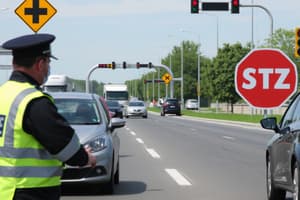Podcast
Questions and Answers
Which type of modelling deals with interactions between vehicles on a microscopic level?
Which type of modelling deals with interactions between vehicles on a microscopic level?
- Car following modelling (correct)
- Traffic flow modelling
- Hydrodynamic modelling
- Spatial observation modelling
In which type of traffic flow are models oriented towards delays, queues, and externalities such as congestion and pollution?
In which type of traffic flow are models oriented towards delays, queues, and externalities such as congestion and pollution?
- Uninterrupted traffic flow
- Interrupted traffic flow (correct)
- Continuous circulation
- Hydrodynamic traffic flow
What does an observer record during a temporal observation according to the text?
What does an observer record during a temporal observation according to the text?
- Traffic variables over road segment 𝐿
- Traffic variables over a specific point 𝑠0 (correct)
- Traffic variables during a specific time period
- Traffic variables during movement
Which type of traffic flow theory involves modelling traffic as a stream and studying traffic variables aggregately?
Which type of traffic flow theory involves modelling traffic as a stream and studying traffic variables aggregately?
What type of traffic interruptions are dealt with in interrupted traffic according to the text?
What type of traffic interruptions are dealt with in interrupted traffic according to the text?
What is the main focus of car following modelling according to the text?
What is the main focus of car following modelling according to the text?
What is the main advantage of camera-based data collection methods?
What is the main advantage of camera-based data collection methods?
What is the main disadvantage of camera-based data collection methods?
What is the main disadvantage of camera-based data collection methods?
How does FCD differ from trajectory data derived from cameras?
How does FCD differ from trajectory data derived from cameras?
What does Automatic Vehicle Identification (AVI) based on an electronic toll collection (ETC) system consist of?
What does Automatic Vehicle Identification (AVI) based on an electronic toll collection (ETC) system consist of?
What is the relationship between speed and flow under continuous circulation?
What is the relationship between speed and flow under continuous circulation?
What are the main components of the Bluetooth readers used for traffic recognition?
What are the main components of the Bluetooth readers used for traffic recognition?
What is floating car data (FCD) collected from?
What is floating car data (FCD) collected from?
What does headway measure in the context of traffic flow?
What does headway measure in the context of traffic flow?
What are the additional information included in extended floating car data (xFCD)?
What are the additional information included in extended floating car data (xFCD)?
What does flow (𝑞) measure in traffic operations?
What does flow (𝑞) measure in traffic operations?
Match the following traffic flow observation methods with their definitions:
Match the following traffic flow observation methods with their definitions:
Match the following traffic flow modelling frameworks with their characteristics:
Match the following traffic flow modelling frameworks with their characteristics:
Match the following types of traffic data collection methods with their advantages:
Match the following types of traffic data collection methods with their advantages:
Match the following types of traffic data with their characteristics:
Match the following types of traffic data with their characteristics:
Match the following terms in traffic operations with their meanings:
Match the following terms in traffic operations with their meanings:
Match the following components of an ETC system with their functions:
Match the following components of an ETC system with their functions:
Match the traffic data collection method with the associated advantage:
Match the traffic data collection method with the associated advantage:
Match the type of data with its derived measurement method:
Match the type of data with its derived measurement method:
Match the traffic flow measurement with its definition:
Match the traffic flow measurement with its definition:
Match the traffic flow modeling focus with its corresponding type:
Match the traffic flow modeling focus with its corresponding type:
Match the disadvantage of camera-based data collection method with its description:
Match the disadvantage of camera-based data collection method with its description:
Match the extended floating car data (xFCD) information with its content:
Match the extended floating car data (xFCD) information with its content:
Match the component of Automatic Vehicle Identification (AVI) based on an electronic toll collection (ETC) system with its function:
Match the component of Automatic Vehicle Identification (AVI) based on an electronic toll collection (ETC) system with its function:
Match the observation during temporal measurements with its definition:
Match the observation during temporal measurements with its definition:
Match the type of traffic flow theory with its focus area:
Match the type of traffic flow theory with its focus area:
Match the feature of FCD with its difference from trajectory data derived from cameras:
Match the feature of FCD with its difference from trajectory data derived from cameras:
Flashcards are hidden until you start studying




